engine coolant Ram 5500 Chassis Cab 2015 Owner's Guide
[x] Cancel search | Manufacturer: RAM, Model Year: 2015, Model line: 5500 Chassis Cab, Model: Ram 5500 Chassis Cab 2015Pages: 599, PDF Size: 4.51 MB
Page 521 of 599
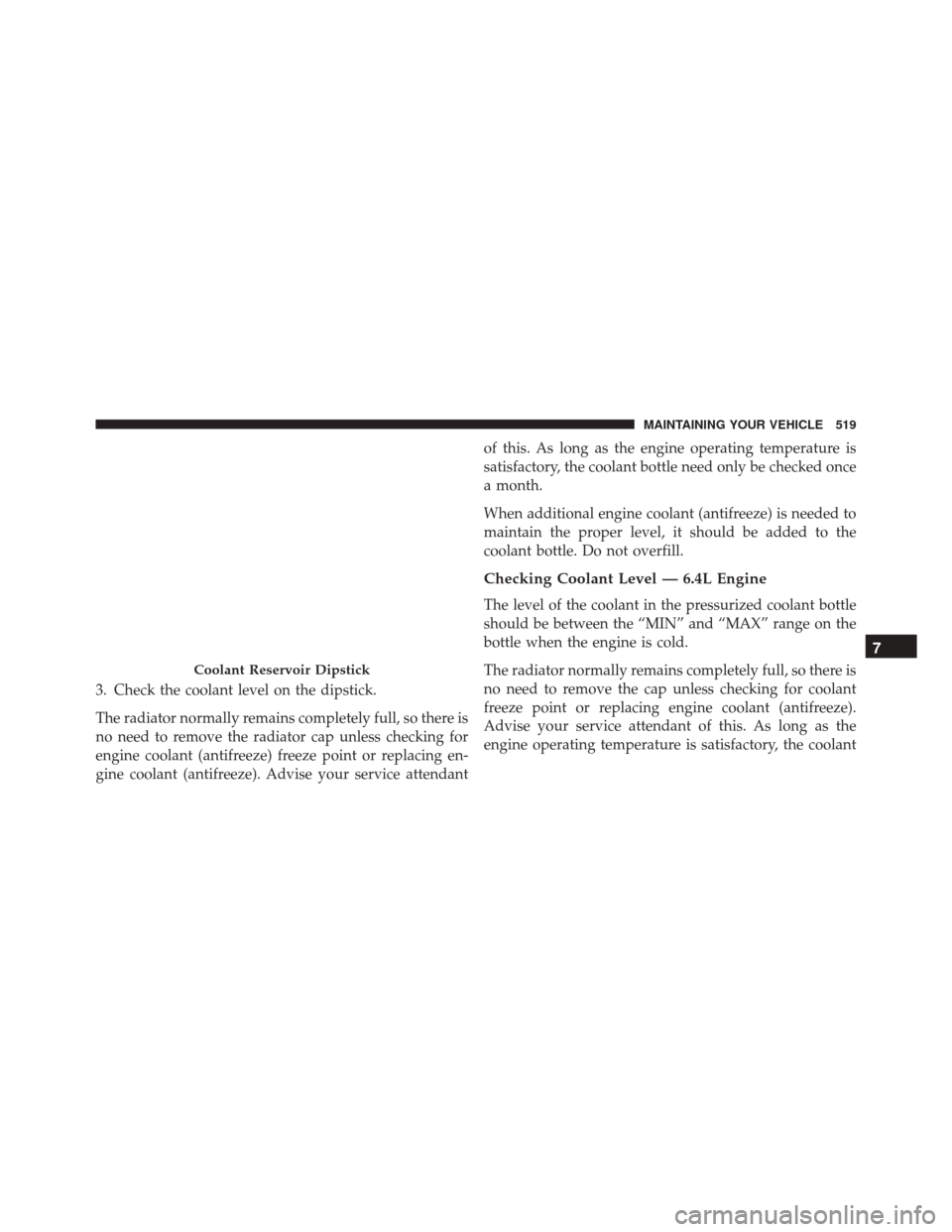
3. Check the coolant level on the dipstick.
The radiator normally remains completely full, so there is
no need to remove the radiator cap unless checking for
engine coolant (antifreeze) freeze point or replacing en-
gine coolant (antifreeze). Advise your service attendantof this. As long as the engine operating temperature is
satisfactory, the coolant bottle need only be checked once
a month.
When additional engine coolant (antifreeze) is needed to
maintain the proper level, it should be added to the
coolant bottle. Do not overfill.
Checking Coolant Level — 6.4L Engine
The level of the coolant in the pressurized coolant bottle
should be between the “MIN” and “MAX” range on the
bottle when the engine is cold.
The radiator normally remains completely full, so there is
no need to remove the cap unless checking for coolant
freeze point or replacing engine coolant (antifreeze).
Advise your service attendant of this. As long as the
engine operating temperature is satisfactory, the coolant
Coolant Reservoir Dipstick
7
MAINTAINING YOUR VEHICLE 519
Page 522 of 599

bottle need only be checked once a month. When addi-
tional engine coolant (antifreeze) is needed to maintain
the proper level, it should be added to the coolant bottle.
Do not overfill.
Points To Remember
NOTE:When the vehicle is stopped after a few miles/
kilometers of operation, you may observe vapor coming
from the front of the engine compartment. This is nor-
mally a result of moisture from rain, snow, or high
humidity accumulating on the radiator and being vapor-
ized when the thermostat opens, allowing hot engine
coolant (antifreeze) to enter the radiator.
If an examination of your engine compartment shows no
evidence of radiator or hose leaks, the vehicle may be
safely driven. The vapor will soon dissipate.
• Do not overfill the coolant expansion bottle. •
Check the coolant freeze point in the radiator and in
the coolant expansion bottle. If engine coolant (anti-
freeze) needs to be added, the contents of the coolant
expansion bottle must also be protected against freez-
ing.
• If frequent engine coolant (antifreeze) additions are
required, the cooling system should be pressure tested
for leaks.
• Maintain engine coolant (antifreeze) concentration at a
minimum of 50% OAT coolant (conforming to
MS.90032) and distilled water for proper corrosion
protection of your engine which contains aluminum
components.
• Make sure that the coolant expansion bottle overflow
hoses are not kinked or obstructed.
• Keep the front of the radiator clean. If your vehicle is
equipped with air conditioning, keep the front of the
condenser clean.
520 MAINTAINING YOUR VEHICLE
Page 523 of 599
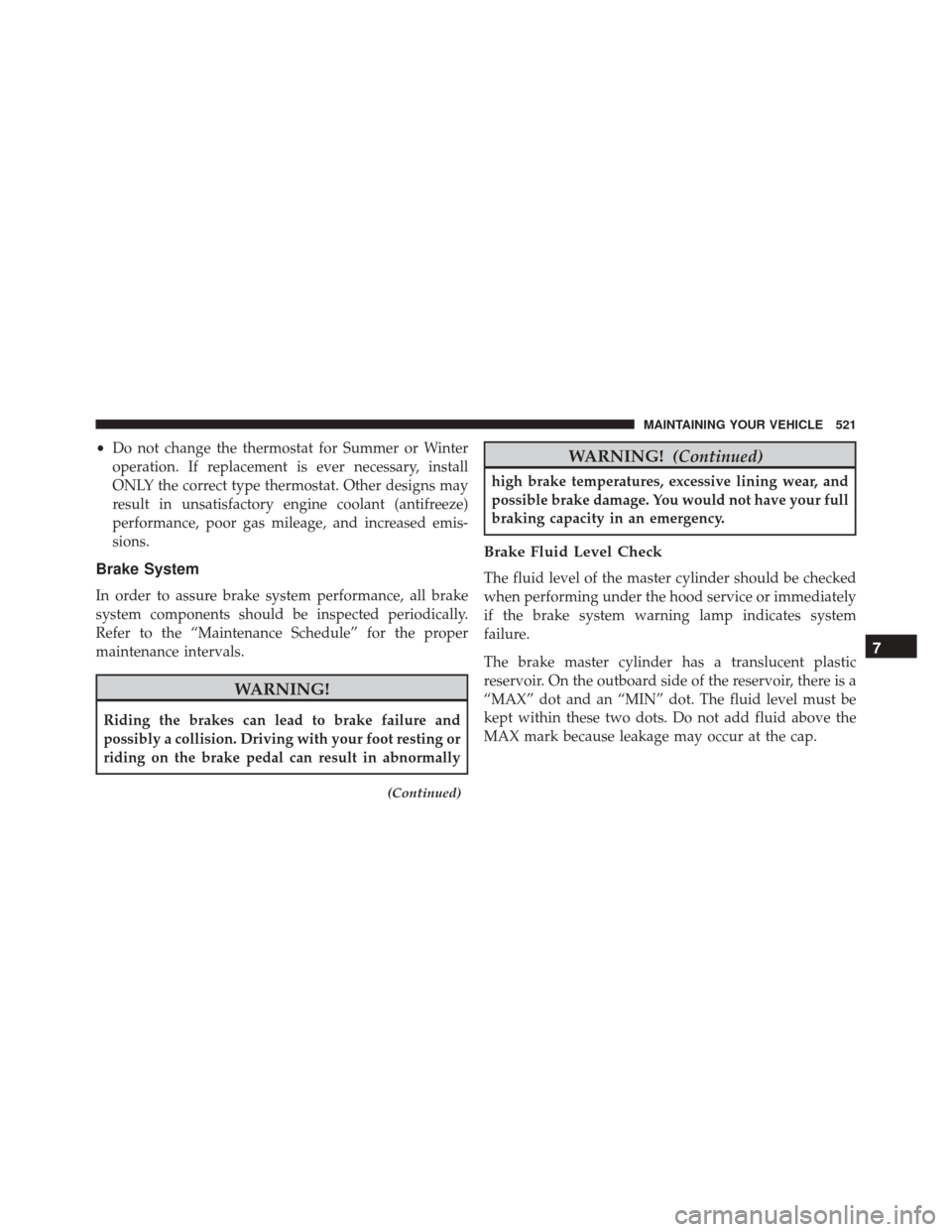
•Do not change the thermostat for Summer or Winter
operation. If replacement is ever necessary, install
ONLY the correct type thermostat. Other designs may
result in unsatisfactory engine coolant (antifreeze)
performance, poor gas mileage, and increased emis-
sions.
Brake System
In order to assure brake system performance, all brake
system components should be inspected periodically.
Refer to the “Maintenance Schedule” for the proper
maintenance intervals.
WARNING!
Riding the brakes can lead to brake failure and
possibly a collision. Driving with your foot resting or
riding on the brake pedal can result in abnormally
(Continued)
WARNING! (Continued)
high brake temperatures, excessive lining wear, and
possible brake damage. You would not have your full
braking capacity in an emergency.
Brake Fluid Level Check
The fluid level of the master cylinder should be checked
when performing under the hood service or immediately
if the brake system warning lamp indicates system
failure.
The brake master cylinder has a translucent plastic
reservoir. On the outboard side of the reservoir, there is a
“MAX” dot and an “MIN” dot. The fluid level must be
kept within these two dots. Do not add fluid above the
MAX mark because leakage may occur at the cap.
7
MAINTAINING YOUR VEHICLE 521
Page 544 of 599

Cavity Cartridge Fuse Micro FuseDescription
F67 10 Amp Red CD / DVD / Bluetooth Hands-free Module –
If Equipped
F69 15 Amp BlueMod SCR 12V (Cummins Diesel) – If
Equipped
F70 30 Amp GreenFuel Pump Motor
F71 25 Amp ClearAmplifier
F72 10 Amp Red Voltage Stabilizer Modules – If Equipped
F73 20 Amp YellowFuel Transfer Pump (HD Only) – If
Equipped
F74 20 Amp Yellow
(Gas Engine &
1500 LD Diesel)
10 Amp Red (Cum-
mins Diesel Engine) Brake Vacuum Pump Gas/Diesel – If
Equipped
F75 10 Amp RedCoolant Temperature Valve Actuator
F76 10 Amp Red Antilock Brakes/Electronic Stability Control
542 MAINTAINING YOUR VEHICLE
Page 556 of 599
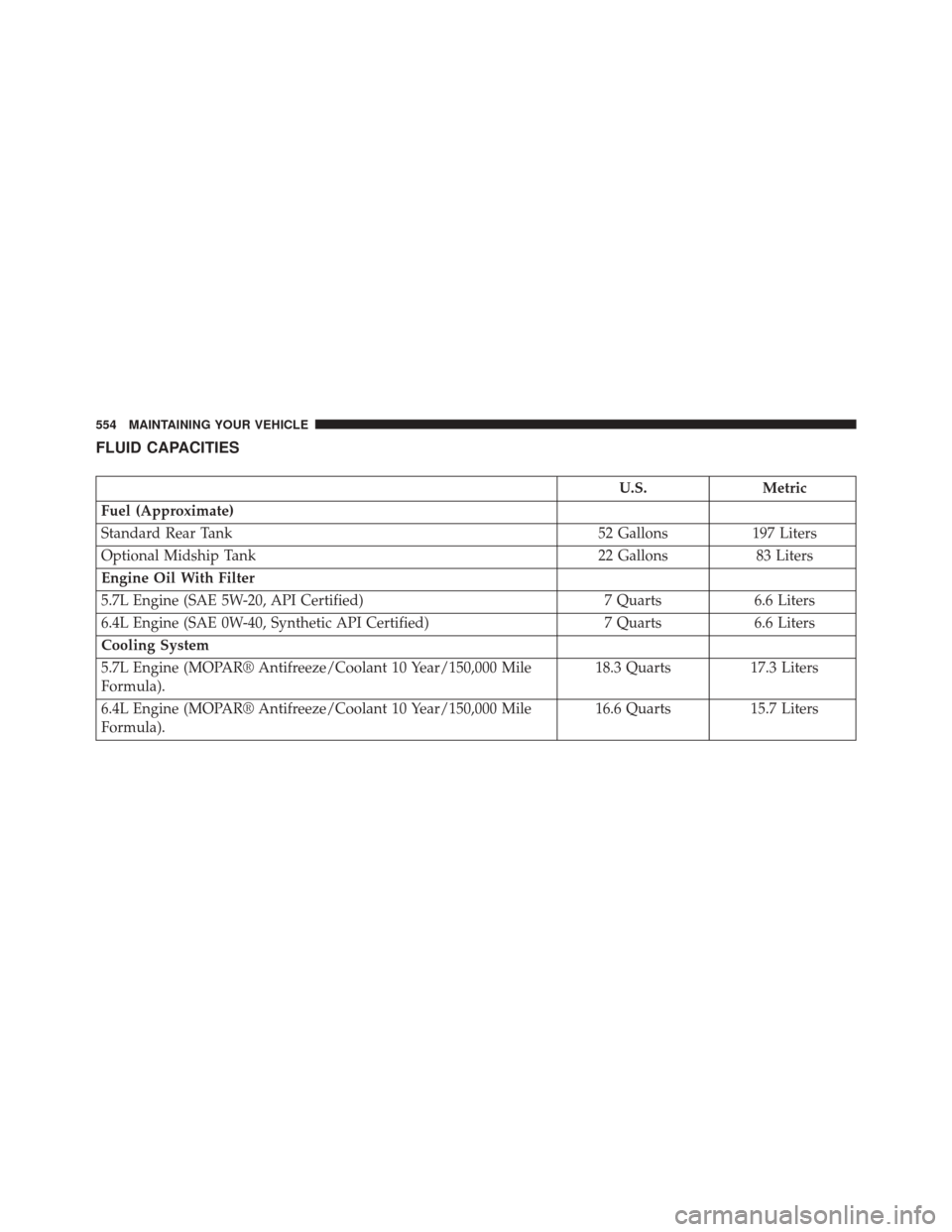
FLUID CAPACITIES
U.S.Metric
Fuel (Approximate)
Standard Rear Tank 52 Gallons197 Liters
Optional Midship Tank 22 Gallons83 Liters
Engine Oil With Filter
5.7L Engine (SAE 5W-20, API Certified) 7 Quarts6.6 Liters
6.4L Engine (SAE 0W-40, Synthetic API Certified) 7 Quarts6.6 Liters
Cooling System
5.7L Engine (MOPAR® Antifreeze/Coolant 10 Year/150,000 Mile
Formula). 18.3 Quarts
17.3 Liters
6.4L Engine (MOPAR® Antifreeze/Coolant 10 Year/150,000 Mile
Formula). 16.6 Quarts
15.7 Liters
554 MAINTAINING YOUR VEHICLE
Page 557 of 599
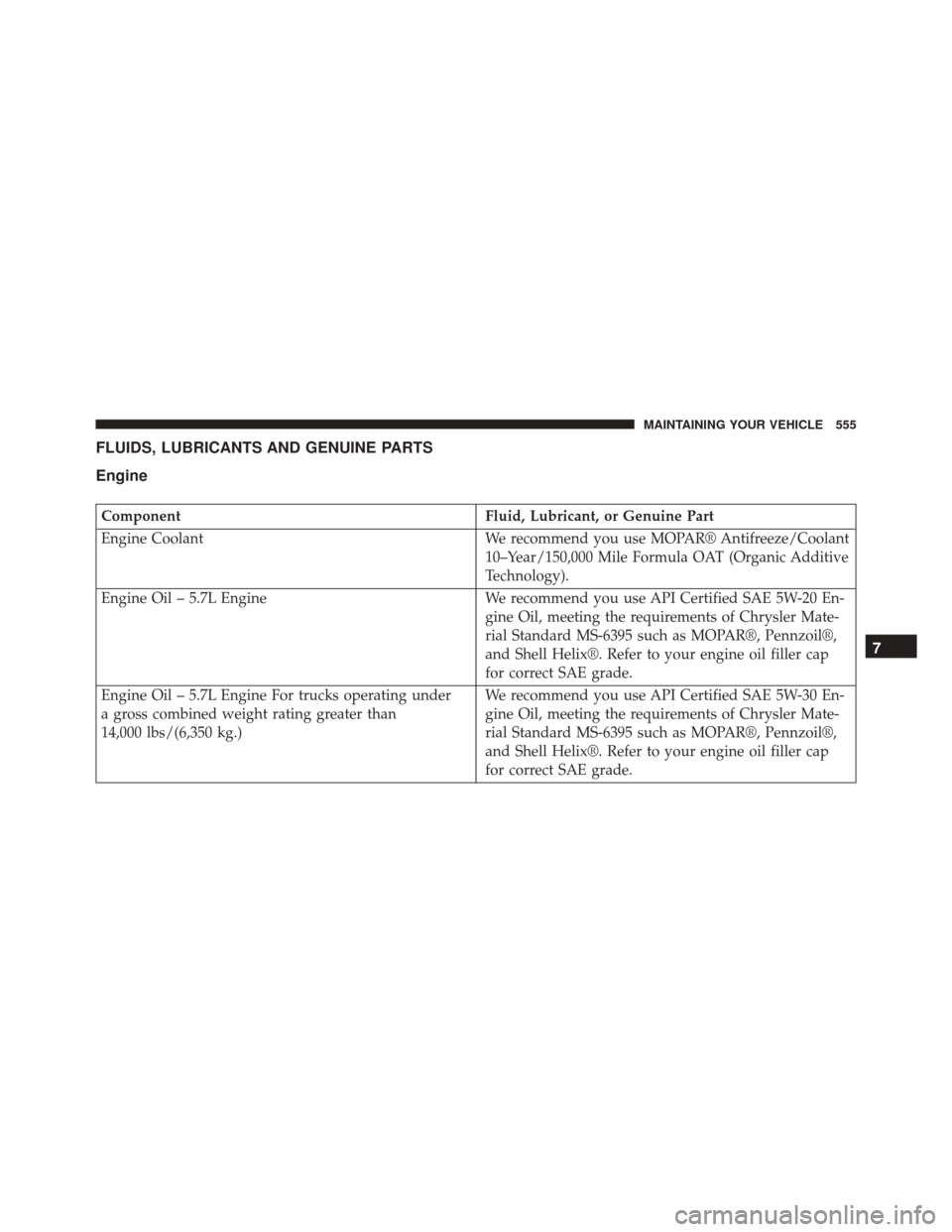
FLUIDS, LUBRICANTS AND GENUINE PARTS
Engine
ComponentFluid, Lubricant, or Genuine Part
Engine Coolant We recommend you use MOPAR® Antifreeze/Coolant
10–Year/150,000 Mile Formula OAT (Organic Additive
Technology).
Engine Oil – 5.7L Engine We recommend you use API Certified SAE 5W-20 En-
gine Oil, meeting the requirements of Chrysler Mate-
rial Standard MS-6395 such as MOPAR®, Pennzoil®,
and Shell Helix®. Refer to your engine oil filler cap
for correct SAE grade.
Engine Oil – 5.7L Engine For trucks operating under
a gross combined weight rating greater than
14,000 lbs/(6,350 kg.) We recommend you use API Certified SAE 5W-30 En-
gine Oil, meeting the requirements of Chrysler Mate-
rial Standard MS-6395 such as MOPAR®, Pennzoil®,
and Shell Helix®. Refer to your engine oil filler cap
for correct SAE grade.
7
MAINTAINING YOUR VEHICLE 555
Page 559 of 599
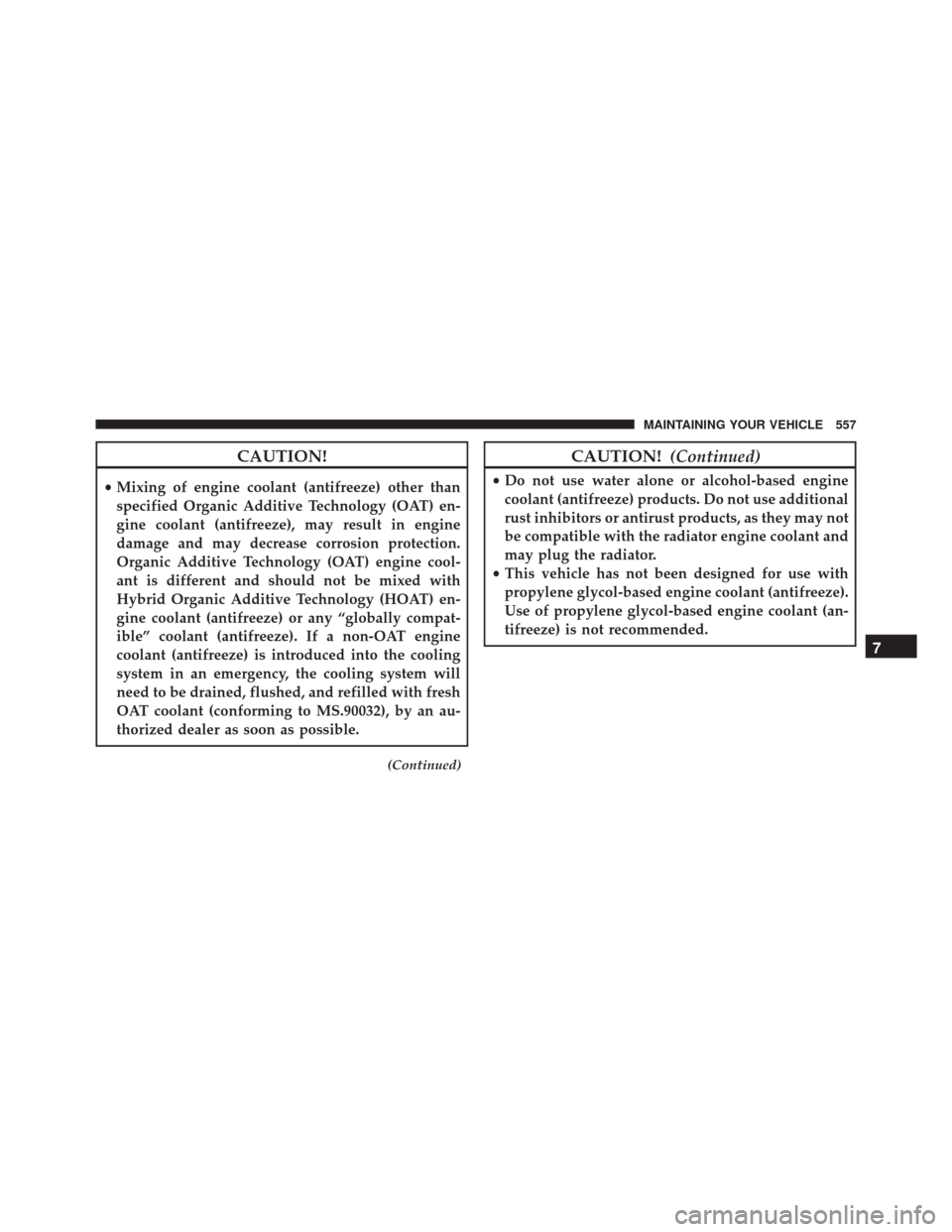
CAUTION!
•Mixing of engine coolant (antifreeze) other than
specified Organic Additive Technology (OAT) en-
gine coolant (antifreeze), may result in engine
damage and may decrease corrosion protection.
Organic Additive Technology (OAT) engine cool-
ant is different and should not be mixed with
Hybrid Organic Additive Technology (HOAT) en-
gine coolant (antifreeze) or any “globally compat-
ible” coolant (antifreeze). If a non-OAT engine
coolant (antifreeze) is introduced into the cooling
system in an emergency, the cooling system will
need to be drained, flushed, and refilled with fresh
OAT coolant (conforming to MS.90032), by an au-
thorized dealer as soon as possible.
(Continued)
CAUTION! (Continued)
•Do not use water alone or alcohol-based engine
coolant (antifreeze) products. Do not use additional
rust inhibitors or antirust products, as they may not
be compatible with the radiator engine coolant and
may plug the radiator.
• This vehicle has not been designed for use with
propylene glycol-based engine coolant (antifreeze).
Use of propylene glycol-based engine coolant (an-
tifreeze) is not recommended.
7
MAINTAINING YOUR VEHICLE 557
Page 563 of 599
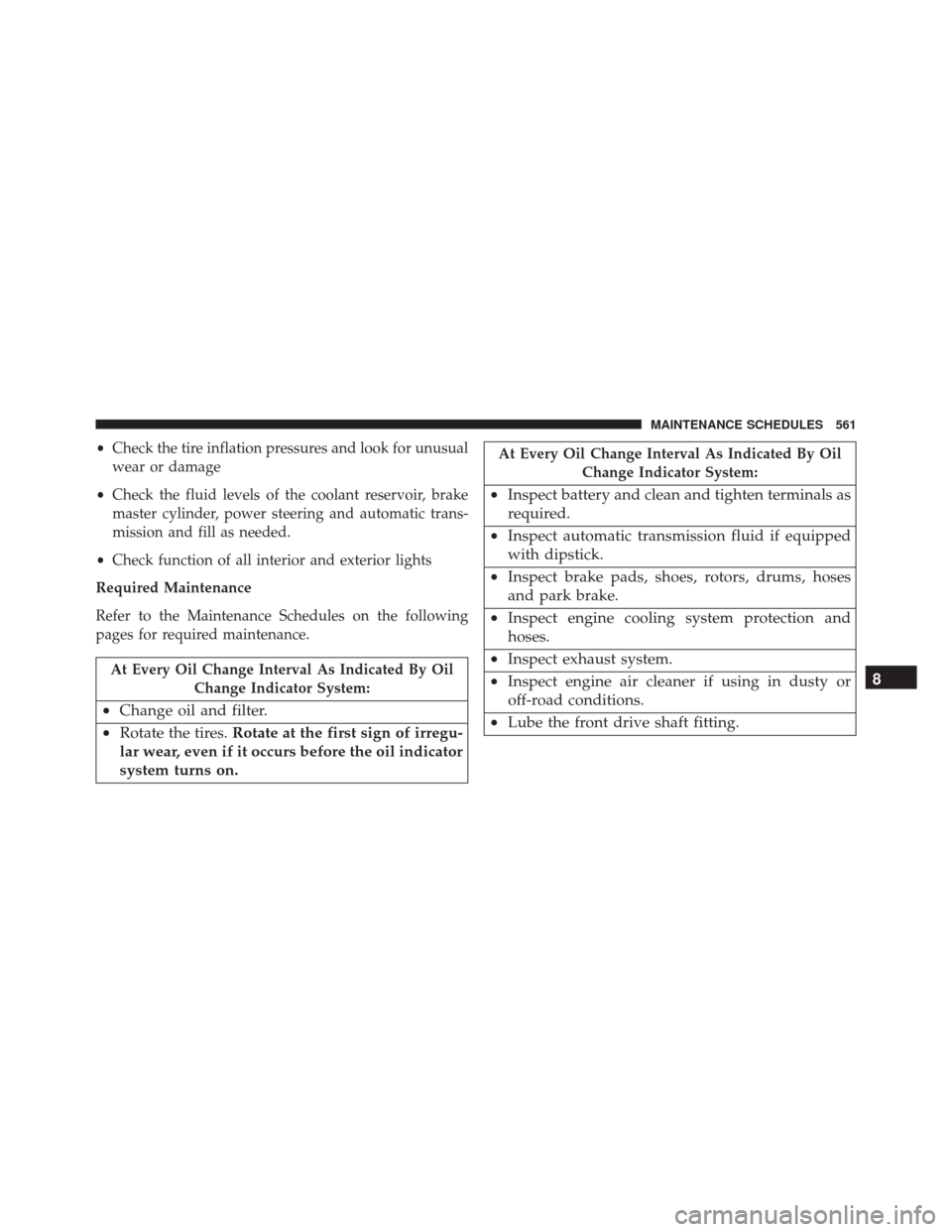
•Check the tire inflation pressures and look for unusual
wear or damage
• Check the fluid levels of the coolant reservoir, brake
master cylinder, power steering and automatic trans-
mission and fill as needed.
• Check function of all interior and exterior lights
Required Maintenance
Refer to the Maintenance Schedules on the following
pages for required maintenance.
At Every Oil Change Interval As Indicated By Oil Change Indicator System:
•Change oil and filter.
• Rotate the tires. Rotate at the first sign of irregu-
lar wear, even if it occurs before the oil indicator
system turns on.
At Every Oil Change Interval As Indicated By Oil Change Indicator System:
•Inspect battery and clean and tighten terminals as
required.
• Inspect automatic transmission fluid if equipped
with dipstick.
• Inspect brake pads, shoes, rotors, drums, hoses
and park brake.
• Inspect engine cooling system protection and
hoses.
• Inspect exhaust system.
• Inspect engine air cleaner if using in dusty or
off-road conditions.
• Lube the front drive shaft fitting. 8
MAINTENANCE SCHEDULES 561
Page 565 of 599
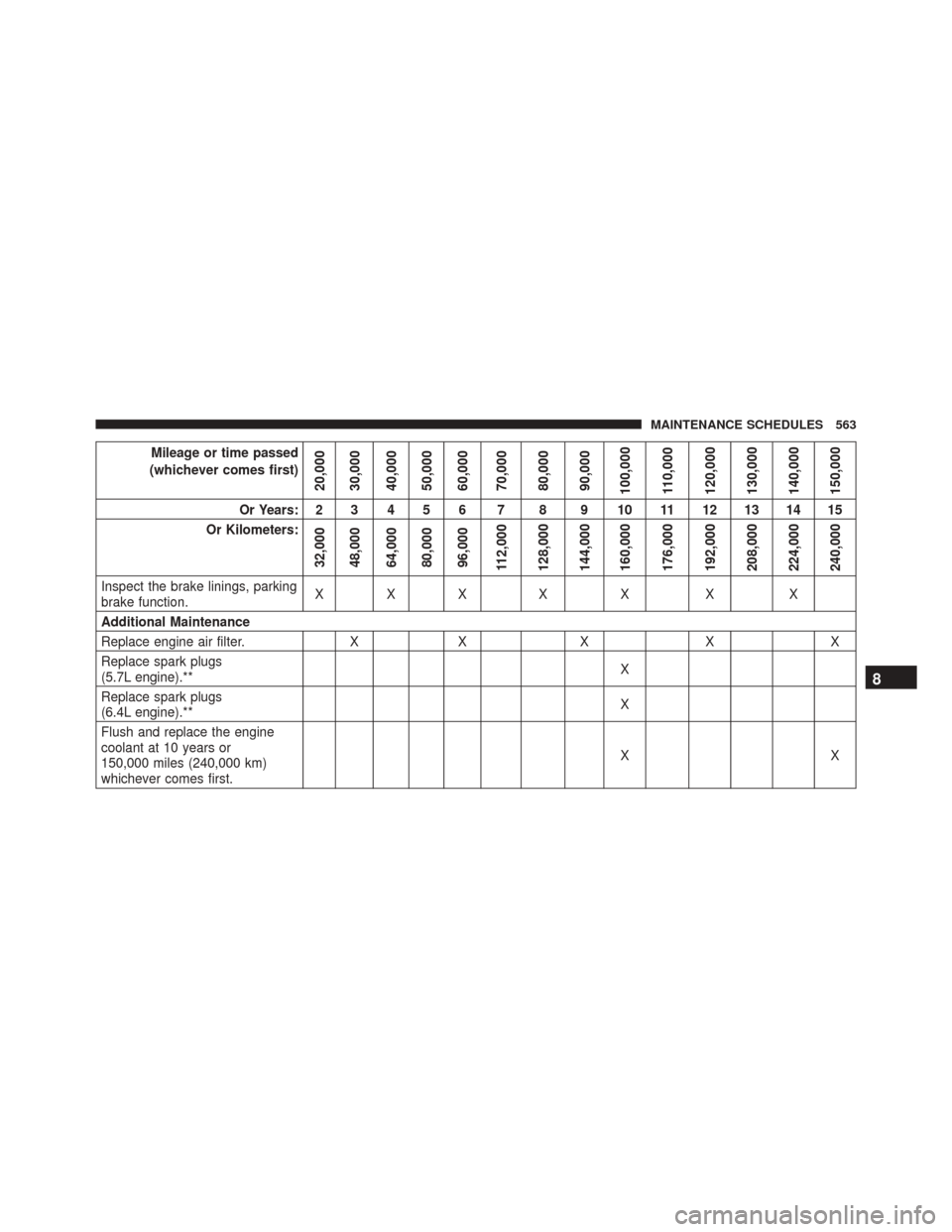
Mileage or time passed
(whichever comes first)
20,000
30,000
40,000
50,000
60,000
70,000
80,000
90,000
100,000
110,000
120,000
130,000
140,000
150,000
Or Years: 2 3 4 5 6 7 8 9 10 11 12 13 14 15
Or Kilometers:
32,000
48,000
64,000
80,000
96,000
112,000
128,000
144,000
160,000
176,000
192,000
208,000
224,000
240,000
Inspect the brake linings, parking
brake function. XXX X X X X
Additional Maintenance
Replace engine air filter. XX X XX
Replace spark plugs
(5.7L engine).** X
Replace spark plugs
(6.4L engine).** X
Flush and replace the engine
coolant at 10 years or
150,000 miles (240,000 km)
whichever comes first. XX
8
MAINTENANCE SCHEDULES 563
Page 580 of 599
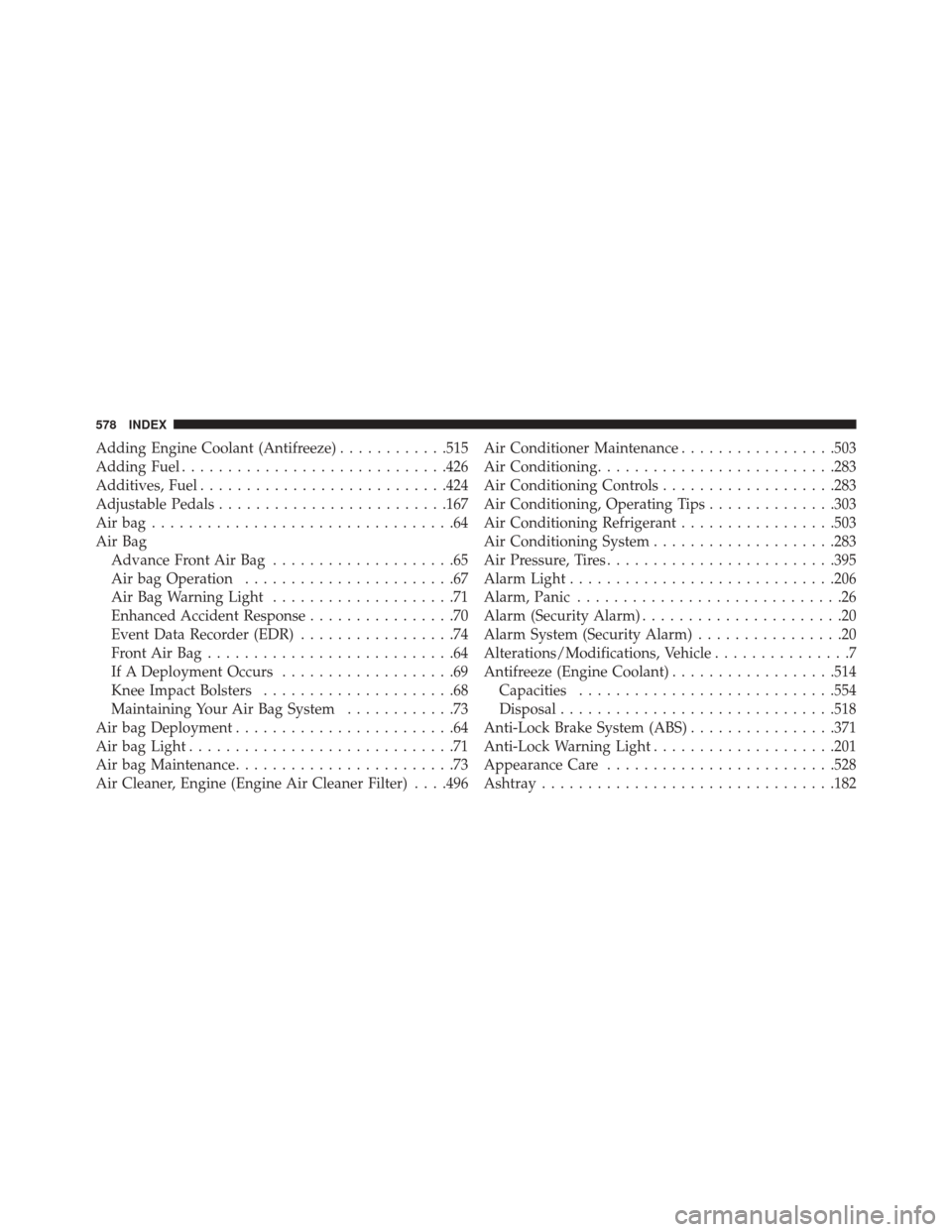
Adding Engine Coolant (Antifreeze)............515
Adding Fuel ............................ .426
Additives, Fuel .......................... .424
Adjustable Pedals ........................ .167
Airbag.................................64
Air Bag Advance Front Air Bag ....................65
Air bag Operation .......................67
Air Bag Warning Light ....................71
Enhanced Accident Response ................70
Event Data Recorder (EDR) .................74
FrontAirBag...........................64
If A Deployment Occurs ...................69
Knee Impact Bolsters .....................68
Maintaining Your Air Bag System ............73
Air bag Deployment ........................64
Air bag Light .............................71
Air bag Maintenance ........................73
Air Cleaner, Engine (Engine Air Cleaner Filter) . . . .496 Air Conditioner Maintenance
.................503
Air Conditioning ......................... .283
Air Conditioning Controls ...................283
Air Conditioning, Operating Tips ..............303
Air Conditioning Refrigerant .................503
Air Conditioning System ....................283
Air Pressure, Tires ........................ .395
Alarm Light ............................ .206
Alarm, Panic .............................26
Alarm (Security Alarm) ......................20
Alarm System (Security Alarm) ................20
Alterations/Modifications, Vehicle ...............7
Antifreeze (Engine Coolant) ..................514
Capacities ........................... .554
Disposal ............................. .518
Anti-Lock Brake System (ABS) ................371
Anti-Lock Warning Light ....................201
Appearance Care ........................ .528
Ashtray ............................... .182
578 INDEX